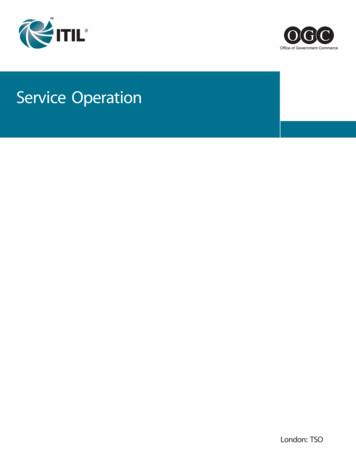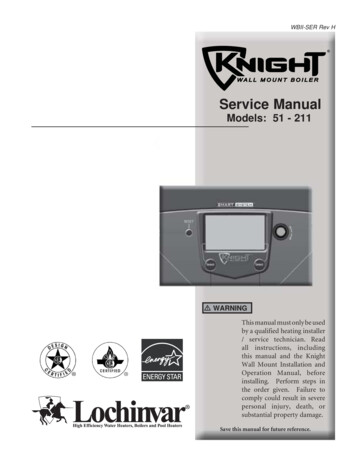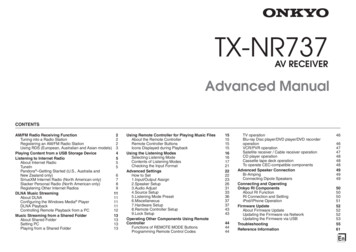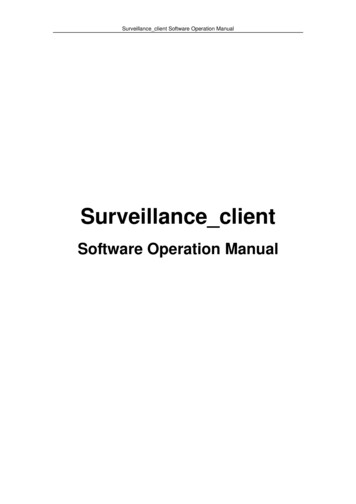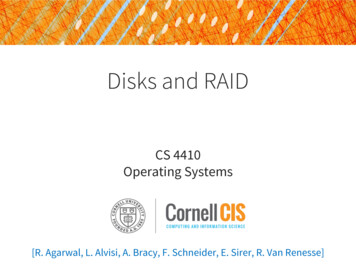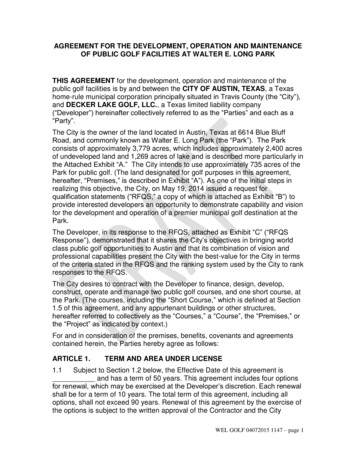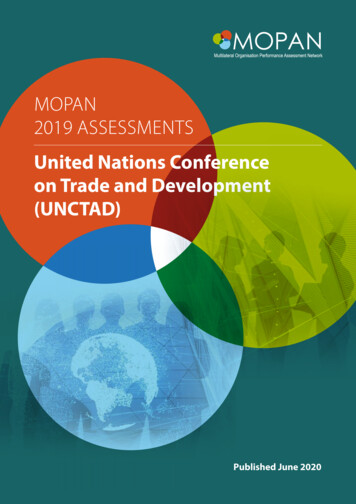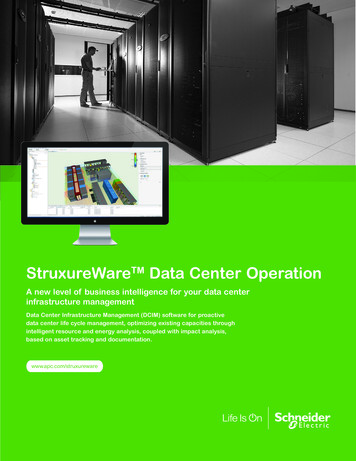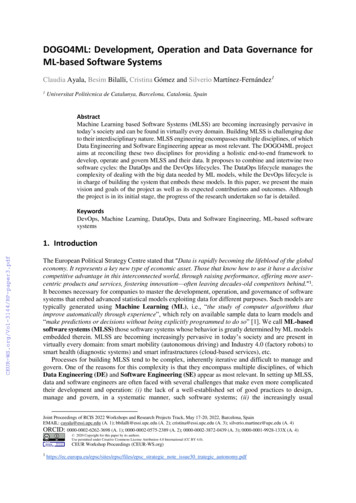
Transcription
DOGO4ML: Development, Operation and Data Governance forML-based Software SystemsClaudia Ayala, Besim Bilalli, Cristina Gómez and Silverio Martínez-Fernández11Universitat Politècnica de Catalunya, Barcelona, Catalonia, SpainAbstractMachine Learning based Software Systems (MLSS) are becoming increasingly pervasive intoday’s society and can be found in virtually every domain. Building MLSS is challenging dueto their interdisciplinary nature. MLSS engineering encompasses multiple disciplines, of whichData Engineering and Software Engineering appear as most relevant. The DOGO4ML projectaims at reconciling these two disciplines for providing a holistic end-to-end framework todevelop, operate and govern MLSS and their data. It proposes to combine and intertwine twosoftware cycles: the DataOps and the DevOps lifecycles. The DataOps lifecycle manages thecomplexity of dealing with the big data needed by ML models, while the DevOps lifecycle isin charge of building the system that embeds these models. In this paper, we present the mainvision and goals of the project as well as its expected contributions and outcomes. Althoughthe project is in its initial stage, the progress of the research undertaken so far is detailed.KeywordsDevOps, Machine Learning, DataOps, Data and Software Engineering, ML-based softwaresystems1. IntroductionThe European Political Strategy Centre stated that “Data is rapidly becoming the lifeblood of the globaleconomy. It represents a key new type of economic asset. Those that know how to use it have a decisivecompetitive advantage in this interconnected world, through raising performance, offering more usercentric products and services, fostering innovation—often leaving decades-old competitors behind.”1.It becomes necessary for companies to master the development, operation, and governance of softwaresystems that embed advanced statistical models exploiting data for different purposes. Such models aretypically generated using Machine Learning (ML), i.e., “the study of computer algorithms thatimprove automatically through experience”, which rely on available sample data to learn models and“make predictions or decisions without being explicitly programmed to do so” [1]. We call ML-basedsoftware systems (MLSS) those software systems whose behavior is greatly determined by ML modelsembedded therein. MLSS are becoming increasingly pervasive in today’s society and are present invirtually every domain: from smart mobility (autonomous driving) and Industry 4.0 (factory robots) tosmart health (diagnostic systems) and smart infrastructures (cloud-based services), etc.Processes for building MLSS tend to be complex, inherently iterative and difficult to manage andgovern. One of the reasons for this complexity is that they encompass multiple disciplines, of whichData Engineering (DE) and Software Engineering (SE) appear as most relevant. In setting up MLSS,data and software engineers are often faced with several challenges that make even more complicatedtheir development and operation: (i) the lack of a well-established set of good practices to design,manage and govern, in a systematic manner, such software systems; (ii) the increasingly usualJoint Proceedings of RCIS 2022 Workshops and Research Projects Track, May 17-20, 2022, Barcelona, SpainEMAIL: cayala@essi.upc.edu (A. 1); bbilalli@essi.upc.edu (A. 2); cristina@essi.upc.edu (A. 3); silverio.martinez@upc.edu (A. 4)ORCID: 0000-0002-6262-3698 (A. 1); 0000-0002-0575-2389 (A. 2); 0000-0002-3872-0439 (A. 3); 0000-0001-9928-133X (A. 4) ️ 2020 Copyright for this paper by its authors.Use permitted under Creative Commons License Attribution 4.0 International (CC BY 4.0).CEUR Workshop Proceedings /files/epsc strategic note issue30 trategic autonomy.pdf
characteristics of Big Data, and (iii) the lack of definition of specific indicators and quality requirementsfor MLSS (e.g., related to trustworthiness or ethics), and tool support for validating them.This paper presents the DOGO4ML project, acronym for Development, Operation and DataGovernance for MLSS. DOGO4ML (https://dogo4ml.upc.edu/en) is a 4-year project that started onSeptember 2021 and it is funded by the Spanish research agency, under the National Spanish Programfor Research Aimed at the Challenges of Society 2020 (RETOS 2020).DOGO4ML is run by the integrated Software, Services, Information and Data Engineering researchgroup (inSSIDE, https://insside.upc.edu/) at the Universitat Politècnica de Catalunya (UPC). inSSIDEis composed of two subgroups: (i) the Software and Service Engineering group (GESSI,https://gessi.upc.edu/en) and (ii) the Database Technologies and Information Management group(DTIM, https://www.essi.upc.edu/dtim/). These two subgroups together cover the relevant aspectsrelated to SE and DE that lay the foundations for DOGO4ML.The rest of the paper is organized as follows. Section 2 and Section 3 present the conceptualizationof DOGO4ML and its objectives, respectively. The expected outcomes of the project are detailed inSection 4. Section 5 sketches the relevance of the project for the ML field. Then, Section 6 summarizesthe initial results of DOGO4ML. Finally, Section 7 presents the conclusions.2. DOGO4ML ConceptualizationThe main objective of the project is to provide a holistic approach to MLSS engineering aligning its DEneeds with SE practices. DOGO4ML proposes a holistic end-to-end framework to develop, operate andgovern MLSS and their data. This framework revolves around a new proposal we call the DevDataOpslifecycle, which unifies two software lifecycles: the DevOps lifecycle and the DataOps lifecycle. TheDevOps cycle aims to transform the requirements of an MLSS into deployed code (Dev) and getfeedback as soon as possible from the end-users (Ops). This can be used to evolve the requirements(including those that apply to the ML models). The DataOps cycle provides support to the datamanagement and analysis processes that characterize MLSS. The DataOps processes are inter-relatedwith those in the Dev phase of the DevOps software cycle, since they produce the required ML models(created through several iterations in the DataOps lifecycle) to be embedded into the ML softwarecomponents of the MLSS. Further, the DataOps cycle aims to get feedback from the data analysts tocontinuously improve the data management and analysis processes. A detailed explanation of theconceptualization of both cycles follows.2.1.The DevOps software cycleDevOps is a software development and delivery process that produces software from itsconceptualization, as well as from the feedback provided by monitors when the software system is inan operational environment. This feedback is then used to maintain and evolve the system. Thespecificity of MLSS requires continuous context-aware delivery, and feedback to adjust and refine theirembedded ML components. Fig. 1 presents the resulting DevOps cycle.In the Dev phase, a typical requirement engineering process applies both at the system and the MLcomponent levels. At the system level, the requirements include quality requirements specific for theMLSS (e.g., trustworthiness and ethics), extracted from a requirement patterns catalogue based on [2]to be built during the project. At the level of the ML components, requirements also include qualityrequirements of ML models (e.g., model accuracy and low latency) which are key to identify andprocess the relevant data for the ML model construction, validation, and operation (see description ofDataOps software cycle in Section 2.2).Going on with the Dev phase, agile practices will be adopted to continuously deliver high-qualityMLSS. The definition of reference architectures and best practices (e.g., iterative integration of MLmodels provided by the DataOps software cycle into ML components), driven by the MLSS qualityrequirements, will enable rapid MLSS implementation and deployment in small iterations. Automatedintegration and testing of those systems will reconcile the particularities of both types of components,ML and non-ML (e.g., in terms of uncertainty in the functional validation). Once validated, the MLSS
will be deployed in its contextual operational environment (e.g., in a type of system with high decisionalcapabilities such as a smart vehicle).Figure 1: The DevOps cycle for MLSS projects proposed by the DOGO4ML project. A zoom-in of theDataOps cycle is in Figure 2.During the Ops phase, the MLSS in production interacts with both the user and the environment.For example, a MLSS for a smart vehicle will receive input from the user (e.g., through voice) and acontinuous stream of sensed data (e.g., data indicating people crossing the street). Through theseinteractions and input, the ML models deployed inside the system are able to make predictions (e.g.,there is an increased risk of accident).While the system is in execution, it generates runtime data, mainly in the form of measurements ofthe system behavior (through monitors) and log files that contain the sequence of time-stampedinteractions. This data will be gathered by a module able to analyze it and assess a set of high-levelindicators that may refer to MLSS quality requirements (e.g., runtime efficiency, trustworthiness of thesystem) or other more general aspects (e.g., users’ ethical behavior). At this respect, we plan to adaptour previous results in: 1) self-adaptive systems monitoring to the area of MLSS [3] and 2) visualizationof high-level indicators and quality requirements in the form of a dashboard [4]. This dashboard, whichwe call the DevOps dashboard, is an essential aspect of the DevOps lifecycle to generate the neededfeedback to impact the Dev cycle, and to close the continuous DevOps loop. Feedback enables theevolution of the MLSS (also including the ML components, by evolving the quality requirements ofML models). Then, the approach starts over again, and the Dev phase uses the feedback to evolve theMLSS. Note that data in operation may thus require revisiting the DataOps lifecycle in another Devphase.2.2.The DataOps software cycleDataOps defines the lifecycle of the data management and analysis processes, characteristic aspects ofMLSS related to DE (see Fig. 2). The complexity and iterative nature of these processes require theirown software cycle specific for data-related aspects. Additionally, these processes are interdependentwith DevOps activities undertaken in the Dev phase. It is thus one of the objectives of the DOGO4MLproject to identify and operationalize such dependencies.Data management processes are responsible to ingest, store, process and prepare data according tothe requirements gathered. These processes, common for the whole organization, are carried out by thedata management backbone system that serves the data in the form of data views (i.e., datasets generatedfrom the wealth of data ingested ready to be consumed). Then, each project, during its requirementengineering process conducted in the DevOps Dev phase, decides the specific subset of data assets (i.e.,data views) required. These data views are the main driver enabling the data analysis processes.
Figure 2: The DataOps cycle for MLSS projects.Data analysis processes include data discovery (i.e., finding the relevant data assets and requestingthe needed data views), feature engineering, data preparation and the model learning. These processes,specific for each project, are carried out by the analysis backbone system that is responsible for learningthe models that will be eventually deployed in the Dev phase. Some works frame the data analysisprocesses into their own lifecycle (e.g., under the concept of MLOps). However, many authors arguethat the complete data lifecycle (management and analysis) should be jointly governed within a singleunified view [5]. In DOGO4ML we follow this approach and the tasks identified by MLOps areconsidered in our DataOps lifecycle.The complexity of the data management and analysis processes requires dedicated data and modelgovernance, embedded in the data governance subsystem. The governance can be achieved by gatheringthe required metadata to automate, trace, monitor and assess specific requirements for the datamanagement and analysis backbones systems.Quality requirements of ML models elicited during the Dev phase (e.g., model accuracy), indicatorsrelated to learning models (generated during the data analysis processes, such as model appropriateness)and indicators related to data (generated during the data management processes, such as quantifyingdata bias or query time when accessing the data views) must be monitored during the operation of thedata ops cycle and visualized through the DataOps dashboard. Those indicators provide feedback thatis key to close the loop with the data cycle. For example, the feedback obtained from monitoring agenerated ML model (e.g., its poor accuracy) may require to consider features from another data view,to learn new models or even ingest a new external data source.2.3.The Holistic software cycleWhile the DevOps and DataOps cycles raise significant challenges by themselves, the emerging grandchallenge is their combination into an overarching cycle smoothly integrating their different processelements (activities, roles, etc.) into a unique holistic process. We already made a first approximationto the problem in the context of trustworthy autonomous systems [6]. Overall, we envisage three majordeterminants.Inter-dependency. Both lifecycles generate a number of inter-dependencies, which, due to theiterative nature of the problem, are not easy to identify, formalize and generalize as to guaranteeadaptability to different scenarios.Context-awareness. We do not aim at defining a universal holistic MLSS lifecycle. Instead, werecognize the fact that different organizations, projects and teams may respond to different contextcharacteristics (e.g., data quality, available human skills, problem size, etc.), and that the MLSSlifecycle needs to be flexible enough as to apply to all of them.Systematization. To assist software and data engineers in customizing the lifecycle according tocontext, DOGO4ML proposes a systematic, tool-supported knowledge-based approach that assists themin: (i) defining parameterized process fragments (possibly inter-dependent with others) that describe
activities that may take part in the holistic cycle; (ii) select the most appropriate process fragments in aparticular context, respecting their inter-dependencies; (iii) combine them into the holistic process.Given these determinants, the project will use situational method engineering (SME) [7] as theconceptual framework for defining MLSS lifecycles. In SME, we can define a library of processfragments (“chunks”) classified according to some context criteria. We will use our knowledge incontext ontologies [8] to define the relevant context criteria in the scope of MLSS. SME supports thecomposition of such chunks (although the current state of the art does not handle the problem of interdependencies), as we have done in previous work (e.g. in the field of software evolution [9]). Toolsupport will take the form of a handy web application establishing a conversation with the engineers toproceed with the context criteria elicitation, chunk selection and final composition.3. ObjectivesBased on the aforementioned DOGO4ML conceptualization, we break down the main objective of theproject into four objectives:1. Specify, design and implement a holistic and configurable end-to-end lifecycle for MLSSaligning SE and DE development and operational processes.2. Specify, design and implement the data-driven Dev phase for MLSS considering qualityrequirements and architectural aspects.3. Specify, design and implement the Ops phase increasing users' trust in MLSS bytransparently monitoring quality requirements in near real-time.4. Specify, design, implement and govern the data management and analysis processes forMLSS in the form of a DataOps lifecycle.4. Expected outcomesIn line with its objectives, the project aims to contribute scientifically to advance the state of the art onthe effective and efficient production and continuous evolution of ML models integrated into MLSS.Although ML models and intelligent systems have existed for a long time, the tight integration amongmodels and software from the different perspectives of development, operation, governance andevolution makes this proposal highly innovative.In particular, this project changes the way in which the interdisciplinary combination of DE and SEproposes the foundation of a new future technology, setting up a baseline (in the form of a proof-ofconcept) ready to be matured and transferred to interested actors.The main assets to be produced in the project that can be individually transferred are:(1) Process support.(1.a) Catalog of SE and DE combinable and customizable process fragments(1.b) Catalog of customizable MLSS holitistic processes(1.c) Tool support to build the appropriate MLSS process using (1.a) and (1.b)(2) Development support.(2.a) Quality model for MLSS with associated catalogs of requirement patterns(2.b) Quality model for ML models(2.c) Software reference architecture (SRA) for MLSS(2.d) Tool support to instantiate the SRA to a given context considering domainrequirements(2.e) Tool support for integration testing including ML and non-ML components(3) Operations support.(3.a) Set of tools for the deployment of MLSS with models customized to context(3.b) Data ingestion infrastructure for monitoring MLSS specific quality requirements(3.c) Set of strategic indicators related to users’ trust in MLSS(3.d) Strategic dashboard to visualize trust-related indicators(4) DataOps support.(4.a) Set of tools to govern the complete data lifecycle in MLSS.
(4.b) Set of tools to semi-automatically manage data quality aspects.(4.c) Set of tools to support the automation of the data analysis tasks.(5) Complete platform. Integrates all the assets above into a single platform.To promote the dissemination, exploitation and technology transfer of these assets, initial plans havebeen designed and will be further elaborated as the project progresses.To foster the dissemination of scientific contributions, the plan targets: (i) industrial dissemination,through participation in industry-oriented meetings and dedicated meetings; (ii) educationaldissemination, incorporating consolidated results at the end of the project into MSc and PhD courses.Regarding technology transfer and exploitation, the aim is to promote and maximize industrycollaborations; capitalization of knowledge and assets in future projects; network growth into newdomains. Therefore, an initial business plan has been designed. Such business plan follows the businessmodel canvas approach [10] including the following drivers: Create awareness in the partners’ ecosystems and beyond (e.g., local networks on the topics ofDE and SE standardization through bodies like IREB, see above); Deployment of the project ideas into the health, insurance and finance, and open publicationsdomains. Regarding these domains, we plan to conduct empirical studies in companies thatexpressed their interest in this project to validate the results of the project; Get advice from world-leading experts in specific areas to enable the encapsulation ofmeaningful transferable parts of the project that will ease the project results’ transferability andthe elaboration of specific supporting tools that will be also integrated to offer an end-to-endsupport tool. The resulting tools from the project will be offered as open source in a public GitHub repositorywith the appropriate licenses and communicated through adequate channels, as for instance theReachOut Platform2, aimed to connect research projects with beta testers and early users on themarket. To offer a catalog of services of all exploitable resources from the project to foster and facilitatetheir adoption (installation, maintenance, etc.).All in all, based on the predicted economic impact of adopting AI/ML from diverse organizations,we expect that the results from the project will contribute to such impact. On the one hand, the WorldEconomic Forum stated that AI/ML are expected to create 133 million new jobs globally by 2022. IDCreported that AI/ML technology spending in Europe for 2019 has increased by 49% over the 2018 figureto reach 5.2 billion. According to a recent survey, AI/ML tools globally are expected to reach US 119Billion by 20253. Yet, according to market analysis firm McKinsey, “Most companies are capturingonly a fraction of the potential value from data and analytics. [. . . ] manufacturing, the public sector,and health care have captured less than 30 percent of the potential value we highlighted five yearsago4.” This is particularly true in Europe, which is “lagging behind in embracing the digital and datarevolution5.” Consequently, any significant advance in the field will have a positive impact not only oneconomic terms but also socially.5. Relevance to information scienceInterest in the development of artificial intelligence, with particular focus on ML has exploded in thepast decade5. This has drawn a lot of research activity and investment, enabling ML models tocontinuously make gains in image recognition, language translation, object recognition, and otherapplications. The latter has raised the need for incorporating ML models inside conventional softwaresystems, requiring a paradigm shift in terms of how these systems are developed and maintained.The DOGO4ML project aims to set the foundations for developing software systems that embracethese new possibilities provided by ML. Consequently, the project is set to address different d5https://aiindex.stanford.edu/report3
that appear as a result of intertwining ML and non-ML components. In particular, since ML models arefed by data, one of the main challenges, with relevance to the information science discipline, is relatedto data and information management. In this regard, DOGO4ML aims to develop an end-to-endoperational data governance framework, identifying and operationalizing the data managementlifecycle and analysis processes. Data management processes are responsible to ingest, store, processand prepare data according to the requirements gathered, and then the ready to be consumed data arethe main driver enabling the data analysis processes. The complexity and iterative nature of theseprocesses requires a dedicated data and model governance that produces and gathers the requiredmetadata to automate, trace, monitor and assess specific quality requirements. The latter can be relatedto (i) the learned models (e.g., model appropriateness or training time), and (ii) the data (e.g.,quantifying data bias, data quality or query time when accessing the data views). The first are interpretedand validated by domain experts assessing the quality of the current model, while the second areinterpreted and analyzed by the data and software engineers. Finally, once this loop of the data cycle isclosed, the resulting learned models are embedded and integrated in the MLSS in the form of an MLcomponent during the Dev phase, as described in Section 2.6. Current resultsAlthough the DOGO4ML project is at an initial stage, we may report some results. To gain a deepinsight about the state-of-the-art related to the project, [11] conducted a systematic mapping study aboutSE approaches for building, operating, and maintaining AI-based systems. This mapping study providesa consolidated background to tackle the project tasks. Furthermore, [12] developed and scrutinized ageneric method that allows to generate pre-processing pipelines, as a step towards automating the datapreparation for ML, which in turn is a critical step for the data analysis part.DOGO4ML will use SME as the conceptual framework for defining MLSS lifecycles (see Section2.3). As a first result to elaborate this framework, [13] proposed a holistic method, applying SME, toconsider data as a new source in requirements elicitation for data-driven systems, as the case of MLSS.Regarding the development support expected outcomes, DOGO4ML aims at providing a softwarereference architecture for MLSS and tool support to instantiate this architecture to a given contextconsidering domain requirements. In this sense, an analysis of the impact of design decisions on theachievement of high-accuracy and low resource-consumption in the context of AI mobile applicationsare provided in [14]. Additionally, in the sentiment analysis domain and as a proof-of-concept, [15] and[16] proposed an architecture able to monitor and analyze the sentiment of tweets shared by end-users.7. ConclusionsIn this paper we have presented the goals and vision of the DOGO4ML project. The expected outcomesand initial results are detailed. So far, all the project tasks are being developed as expected and the firstresults confirmed that the project is progressing in the right direction. More information is available onthe project website, https://dogo4ml.upc.edu/en.AcknowledgementsThis paper has been funded by the Spanish Ministerio de Ciencia e Innovación under project /funding scheme PID2020-117191RB-I00 / AEI/10.13039/501100011033.References[1] A.L. Samuel, Some Studies in Machine Learning Using the Game of Checkers. IBM Journal ofResearch and Development 44 (1959) 206–226. doi: 10.1147/rd.33.0210.[2] M. Oriol, S. Martínez-Fernández, W. Behutiye, C. Farré, R. Kozik, P. Seppänen, A. M. Vollmer,P. Rodríguez, X. Franch, S. Aaramaa, A. Abhervé, M. Choraś, J. Partanen, Data-driven and Tool-
supported Elicitation of Quality Requirements in Agile Companies, Software Quality Journal 28(2020) 931-963. doi: 10.1007/s11219-020-09509-y.[3] E. Zavala, X. Franch, J. Marco, Adaptive Monitoring: A Systematic Mapping, Information andSoftware Technology 105 (2019) 161-189. doi: 10.1016/J.INFSOF.2018.08.013.[4] L. López, M. Manzano, C. Gómez, M. Oriol, C. Farré, X. Franch, S. Martínez-Fernández, A.M.Vollmer, QaSD: A Quality-aware Strategic Dashboard for supporting decision makers in AgileSoftware Development, Science of Computer Programming 202 (2021). doi:10.1016/j.scico.2020.102568.[5] V. Khatri, C.V. Brown, Designing Data Governance. Communications of the ACM 53 (2010) 148152. doi: 10.1145/1629175.1629210.[6] S. Martínez-Fernández, X. Franch, A. Jedlitschka, M. Oriol, A. Trendowicz, Developing andOperating Artificial Intelligence Models in Trustworthy Autonomous Systems. In: Cherfi, S.,Perini, A., Nurcan, S. (eds) Research Challenges in Information Science. RCIS 2021. LectureNotes in Business Information Processing, vol 415. Springer, Cham. doi: 10.1007/978-3-03075018-3 14[7] B. Henderson, J. Ralyté, P. Ågerfalk, M. Rossi, Situational Method Engineering. Springer, 2014.[8] O. Cabrera, X. Franch, J. Marco, 3LConOnt: A Three-level Ontology for Context Modelling inContext-aware Computing. Software System and Modelling 18 (2019) 1345–1378. doi:10.1007/s10270-017-0611-z.[9] X. Franch, J. Ralyté, A. Perini, A. Abelló, D. Ameller, J. Gorroñogoitia, S. Nadal, M. Oriol, N.Seyff, A. Siena, A. Susi, Situational Approach for the Definition and Tailoring of a Data-DrivenSoftware Evolution Method, in: Proceedings of the Advanced Information Systems Engineering,CAiSE’18, Springer, 2018, LNCS 10816, pp. 603-618. doi: 10.1007/978-3-319-91563-0 37.[10] A. Osterwalder, Y. Pigneur, Business Model Generation: A Handbook for Visionaries, GameChangers, and Challengers. Wiley, 2010.[11] S. Martínez-Fernández, J. Bogner, X. Franch, M. Oriol, J. Siebert, a. Trendowicz, A.M. Vollmer,S. Wagner, Software Engineering for AI-Based Systems: A Survey, ACM Transactions onSoftware Engineering and Methodology, Vol. 31, No. 2, Article 37e (2022), 59 pages. doi:10.1145/3487043[12] J. Giovanelli, B. Bilalli, A. Abelló, Data pre-processing pipeline generation for AutoETL,Information Systems, In Press, 2021. doi: 10.1016/j.is.2021.101957.[13] X. Franch, A. Henriksson, J. Ralyté, J. Zdravkovic, Data-Driven Agile Requirements Elicitationthrough the Lenses of Situational Method Engineering, in: Proceedings of the IEEE 29th IEEEInternational Requirements Engineering Conference (RE’21), RE@Next! Track, 2018, pp. 402407. Doi: 10.1109/RE51729.2021.00045.[14] R. Creus, S. Martínez, X. Franch, Which Design Decisions in AI-enabled Mobile ApplicationsContribute to Greener AI?, ESEM 2021, URL: https://arxiv.org/abs/2109.15284.[15] A. de Arriba, M. Oriol, X. Franch, Merging Datasets for Emotion Analysis. An Approach usingBETO on Spanish Tweets, 2nd International Workshop on Software Engineering Automation: ANatural Language Perspective, NLP-SEA@ASE‘21). doi: 10.1109/ASEW52652.2021.00051.[16] A. de Arriba, M. Oriol, X. Franch, Applying Transfer Learning to Sentiment Analysis in SocialMedia, Proceedings of the 5th International Workshop on Crowd-Based RequirementsEngineering (CrowdRE’21), 2021, pp. 342-348, 2021. doi: 10.1109/REW53955.2021.00060.
The complexity of the data management and analysis processes requires dedicated data and model governance, embedded in the data governance subsystem. The governance can be achieved by gathering the required metadata to automate, trace, monitor and assess specific requirements for the data management and analysis backbones systems.


